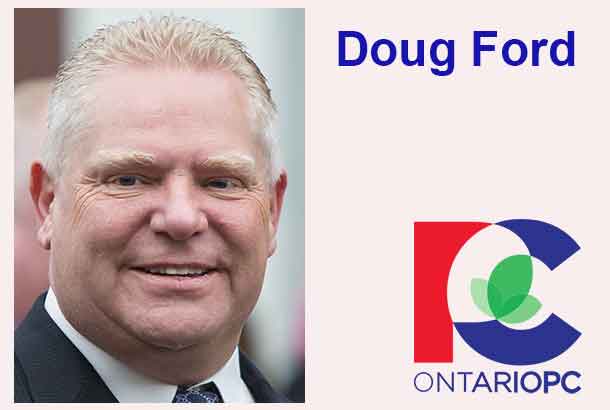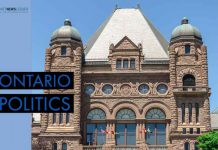
There’s no evidence the tribal loyalty of the past can exist today. And today’s financial limits will ultimately handicap any government
By Pat Murphy
Columnist
With Doug Ford’s surprisingly decisive Ontario election win, you might wonder about going back to the future. Specifically, is the Progressive Conservatives’ fabled Big Blue Machine rolling again?
Younger voters may find this hard to credit, but there was a time when the Progressive Conservatives consistently dominated Ontario politics. Beginning in 1943, they won 12 consecutive elections, nine with outright majorities. When the dynasty ended in 1985, they’d been in power for 42 straight years.
The term Big Blue Machine was coined to describe the combination of organizational depth and marketing smarts that defined the party’s operation. It was deeply rooted, broadly based and a potent blend of suburban and rural. It often seemed invincible.
While it’s always iffy to characterize a political party’s support, Anglo-Celtic Protestant would be an apt broad-brush description of the PCs’ mid-20th century Ontario base. Given the province’s history and demographics, that was a powerful vote-getting profile.
On three occasions – 1951, 1955 and 1963 – the party polled more than 48 percent of the vote in a lively three-party environment. Between 1945 and 1971, it was always comfortably north of 40 percent.
The 12 winning elections involved four premiers. George Drew and Leslie Frost each won three, John Robarts won two and Bill Davis took the honours four times. Mind you, two of the Davis victories were minorities and the dynasty was starting to look tired by the time he departed.
Electoral politics has always had a substantial tribal dimension. For various reasons – such as history, heritage, social class and ideology – people identify with a particular party and reliably vote that way.
Although such tribal loyalty was a critical component, Ontario’s Progressive Conservatives had more than that going for them. When push came to shove, they were extraordinarily pragmatic. Conservatism notwithstanding, they were very adept at using government to pursue popular social objectives.
Drew standardized Ontario’s electricity system and increased funding for roads and schools. And Frost continued the pattern, creating the 400 series of highways, including the 401.
Often called Old Man Ontario, Frost was a prodigious worker, simultaneously serving as premier and treasurer. To quote journalist and author Steve Paikin, “The fact was, he knew the ins and outs of his ministries better than most of his ministers.”
Further, Frost’s careful activism wasn’t confined to infrastructure and education. Working in collaboration with the federal government, there was the expansion of public pension coverage in 1951 and the introduction of public hospital insurance in 1957. And three iterations of anti-discrimination legislation provided the foundation for the subsequent Ontario Human Rights Code.
If anything, Frost’s successors – Robarts and Davis – picked up the pace.
Robarts liked to build things. So with Ontario booming and revenue pouring into the provincial treasury, there was no compunction about spending money.
Inter-regional public transit (the GO system) was launched in 1967. There were also new universities, a community college system and much more.
Other than sheer exhaustion, there are several reasons why such a successful dynasty came a cropper.
One has to do with the party’s ideological shift. After a decade in the wilderness, it returned to power in 1995, running on what leader Mike Harris dubbed the Common Sense Revolution. Then it actually followed through.
Although deeply controversial, the Harris government was initially popular, winning re-election with a slightly higher vote share (45.1 percent) in 1999. To many people, Harris was just doing what needed to be done.
However, the tough sheriff cleaning up town eventually alienates a lot of people, particularly if he sometimes overreaches – as Harris did. Consequently, the party’s brand suffered.
Another reason has to do with Ontario’s changing demographics. Anglo-Celtic Protestants are no longer the dominant force they once were and the party’s pull on tribal loyalty is correspondingly diminished.
Finally, there’s the matter of financial limits.
It’s much easier to embark on popular new initiatives when government’s existing share of the economy is low, as it was in Frost’s 1950 Ontario. Those days, though, are gone.
New spending now implies high public debt levels, making compensatory cuts elsewhere or raising taxes that people already feel are too high.
The bottom line is that the Big Blue Machine isn’t really rolling again. Its winning formula of combining tribal loyalty with financial running room has been overtaken by events.
Columnist Pat Murphy casts a history buff’s eye at the goings-on in our world. Never cynical – well, perhaps just a little bit.
© Troy Media
The views, opinions, and positions expressed by all columnists and contributors are the author’s alone. They do not inherently or expressly reflect the views, opinions and/or positions of NetNewsLedger.





